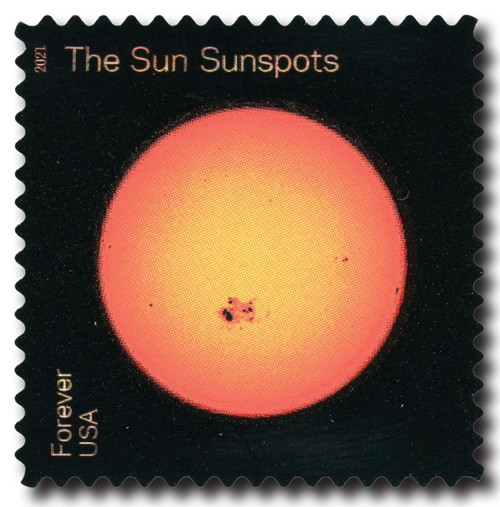
# 5602 - 2021 First-Class Forever Stamp - Sun Science: Plasma Blast
US #5602
2021 Plasma Blast – Sun Science
- Pictures a plasma blast on the sun
- One of 10 stamps in the Sun Science set
Stamp Category: Commemorative
Set: Sun Science
Value: 55¢ First Class Mail Rate (Forever)
First Day of Issue: June 18, 2021
First Day City: Greenbelt, Maryland
Quantity Issued: 18,000,000
Printed by: Banknote Corporation of America
Printing Method: Flexographic, Foil Stamping
Format: Panes of 20
Tagging: Phosphor, block tag
Why the stamp was issued: To showcase the powerful and mysterious science behind the functioning of our sun.
About the stamp design: Pictures a colorized images from NASA’s Solar Dynamics Observatory of a plasma blast on the sun. According to NASA, the color of this stamp represents an image of the sun as viewed with “a blend of extreme ultraviolet wavelengths 171 and 304 Angstroms.”
First Day City: The First Day of Issue Ceremony was held at Greenbelt Main Post Office. It was originally to be held at the NASA Goddard Space Flight Center, but was moved due to observance of the Juneteenth Federal Holiday and the facility being closed.
About the Sun Science set: Includes 10 stamp designs picturing different details of our sun along with phenomena associated with it. Each design pictures a colorized image from NASA’s Solar Dynamics Observatory. The different colors represent a different wavelength that reveals or highlights a particular aspect of our sun.
History the stamp represents: Most of the time, people describe the Sun as a massive ball of hot gas. While this isn’t entirely incorrect, it is more accurate to say the Sun is a massive ball of hot plasma.
In school, we were all taught the three states of matter: solid, liquid, and gas. However, there is also a fourth state, known as plasma. Plasma comes from the ancient Greek word for “moldable substance” and was first studied in the 1920s. Plasma occurs when a gas with a neutral electrical charge is superheated or exposed to a very strong electromagnetic field. At this point, the gas becomes “ionized” and known as plasma. This state of matter is highly conductive and is easily influenced by electric or magnetic fields – even at great distances.
Plasma can be a bit confusing to understand, but looking at real-life examples can help. For instance, lightning, neon signs, and, of course, the Sun, are all forms of plasma. In fact, plasma is actually the most abundant type of ordinary matter in the universe! As you can probably tell from these examples, plasma is often extremely hot and gives off quite a bit of light. The Sun’s plasma is generated by the intense nuclear fusion reactions occurring within its core.
Sun science is a bit technical, but it’s still fun to learn about the star at the center of our solar system!
US #5602
2021 Plasma Blast – Sun Science
- Pictures a plasma blast on the sun
- One of 10 stamps in the Sun Science set
Stamp Category: Commemorative
Set: Sun Science
Value: 55¢ First Class Mail Rate (Forever)
First Day of Issue: June 18, 2021
First Day City: Greenbelt, Maryland
Quantity Issued: 18,000,000
Printed by: Banknote Corporation of America
Printing Method: Flexographic, Foil Stamping
Format: Panes of 20
Tagging: Phosphor, block tag
Why the stamp was issued: To showcase the powerful and mysterious science behind the functioning of our sun.
About the stamp design: Pictures a colorized images from NASA’s Solar Dynamics Observatory of a plasma blast on the sun. According to NASA, the color of this stamp represents an image of the sun as viewed with “a blend of extreme ultraviolet wavelengths 171 and 304 Angstroms.”
First Day City: The First Day of Issue Ceremony was held at Greenbelt Main Post Office. It was originally to be held at the NASA Goddard Space Flight Center, but was moved due to observance of the Juneteenth Federal Holiday and the facility being closed.
About the Sun Science set: Includes 10 stamp designs picturing different details of our sun along with phenomena associated with it. Each design pictures a colorized image from NASA’s Solar Dynamics Observatory. The different colors represent a different wavelength that reveals or highlights a particular aspect of our sun.
History the stamp represents: Most of the time, people describe the Sun as a massive ball of hot gas. While this isn’t entirely incorrect, it is more accurate to say the Sun is a massive ball of hot plasma.
In school, we were all taught the three states of matter: solid, liquid, and gas. However, there is also a fourth state, known as plasma. Plasma comes from the ancient Greek word for “moldable substance” and was first studied in the 1920s. Plasma occurs when a gas with a neutral electrical charge is superheated or exposed to a very strong electromagnetic field. At this point, the gas becomes “ionized” and known as plasma. This state of matter is highly conductive and is easily influenced by electric or magnetic fields – even at great distances.
Plasma can be a bit confusing to understand, but looking at real-life examples can help. For instance, lightning, neon signs, and, of course, the Sun, are all forms of plasma. In fact, plasma is actually the most abundant type of ordinary matter in the universe! As you can probably tell from these examples, plasma is often extremely hot and gives off quite a bit of light. The Sun’s plasma is generated by the intense nuclear fusion reactions occurring within its core.
Sun science is a bit technical, but it’s still fun to learn about the star at the center of our solar system!













